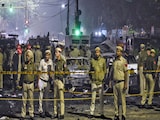For more than two decades, the forests of Bastar whispered one name with dread - Madvi Hidma. A phantom to security forces, a legend among Maoists, and the mastermind behind India's deadliest Naxal attacks, Hidma's story was a mix of brutality, brilliance, and near-mythical survival.
Today, that chapter has finally closed. Hidma, the most feared guerrilla commander of the CPI (Maoist), was killed in an encounter in the dense Maredmilli forests along the Chhattisgarh-Andhra Pradesh border on Tuesday morning. With him fell his wife Rajakka and four of his closest fighters, ending an era of ambushes that scarred India's internal security history.
To understand the weight of this moment, one must rewind to Tadmetla in 2010, where 76 CRPF personnel were slaughtered in an ambush so meticulously crafted that senior officers still refer to it as "the day the jungle swallowed a battalion."
It was Hidma's debut on the national map as a lean, little-known company commander who designed an attack that stunned even seasoned anti-Naxal strategists. Ten years later, investigators would confirm what insiders already knew: the Tadmetla massacre wasn't just an attack; it was the coronation of a new Maoist warlord. And that was only the beginning.
The Jhiram Valley attack of 2013, perhaps the most shocking political assassination in the state's history, further cemented Hidma's rise. On that blood-soaked afternoon, several of Chhattisgarh's top Congress leaders, including Mahendra Karma, Nand Kumar Patel, and others, were killed in a brutal operation executed with military precision.
Many believe the strategic blueprint bore Hidma's signature. The ease with which the Maoists executed that ambush propelled him from the Dandakaranya Special Zonal Committee into the Maoist Central Committee, a rare achievement for someone not from Telangana, the party's traditional power base.
From there, Hidma's battalion became the spearhead of Maoist operations across South Bastar in Bijapur, Sukma, Dantewada and beyond. His men moved like ghosts; his ambushes were handcrafted traps; his understanding of jungle warfare unmatched.
In 2017, his ruthlessness resurfaced in the Burkapal attack, where 25 CRPF jawans were killed. In Minpa, the Tekulguda ambush left 21 soldiers martyred, reaffirming the grim truth security forces had known for years: when blood was spilt in Bastar, Hidma's shadow was rarely far.
Yet, behind the monster was a man whose life seemed born from the soil of these forests. Recruited at 16 from Purvati village under Jagargunda police station, Hidma entered the Maoist fold through the children's wing, "Bal Sangam."
According to former DVCM Badarna, the man who recruited him, Hidma was quick-footed, sharp, and absorbed guerrilla training with uncanny speed. He learned to sing revolutionary songs, use traditional instruments, administer first aid, prepare herbal medicines, and read the jungle like scripture. He was married even before joining the outfit, and after rising through its ranks, married again, his second wife, Rajakka, often accompanying him on operations.
Contrary to many rumours, Hidma did not speak fluent English; he communicated in Gondi, Halbi, Hindi, Telugu, and a bit of Marathi from his posting in Gadchiroli.
What he lacked in formal education, he compensated for with technology. Former associates say he always carried a tablet, a mobile phone, and sometimes a camera or laptop. He filmed every ambush, recording the position of every fighter, every bullet, every mistake, turning the Maoist camp into a classroom of blood and strategy.
Videos recovered after encounters confirmed that the dreaded Battalion No. 1, under Hidma's command, reviewed each operation the way a military academy evaluates war exercises.
Security forces tried to corner him at least half a dozen times. More than 100 soldiers were martyred in these attempts. Each time, Hidma evaded arrest by disappearing into the jungle's maze. With four to five layers of armed security circling him like a moving fortress, he was almost impossible to trace.
Even when police received specific intelligence, as in the Dantewada market of Kistaram, Hidma slipped away unnoticed. The only photograph in police records was over 25 years old, showing a thin, almost fragile young man with a faint moustache, nothing like the hardened commander he had become.
His status in the underground world bordered on mythical. Former cadres said he was tough on security forces but treated his soldiers with respect, unlike many Maoist leaders. He laughed with them, cooked for them, performed rituals with them, and still led them into the deadliest ambushes India has seen.
In the ideological hierarchy of Dandakaranya, he was the only non-Telangana tribal to rise to the Central Committee as a symbolic face of "Bastar's rebellion," as Maoist pamphlets described him.
And yet, for all the folklore, Hidma remained a tragic figure. He was a tribal boy who could have lived an ordinary life, but instead became the architect of massacres.
On Tuesday morning, that path ended. Deep inside the Maredmilli forest, a joint operation cornered Hidma's group. The exchange of fire was brief but decisive. When the smoke cleared, India's most-wanted Maoist commander lay dead. His wife and four associates lay beside him. And with them died the final symbol of a movement that has been weakening under relentless pressure from security forces.
Villagers in Bastar say the jungle feels different today, quieter, lighter, as if a long-standing darkness has been lifted. Officers who spent their careers hunting him down describe the moment as "the closing of the bloodiest chapter in Bastar's modern history."
For years, rumours of Hidma's death had surfaced, only for him to reappear with another devastating attack. This time, the confirmation came from the ground photographs, recoveries, and bodies that leave no room for doubt.
Hidma's end does not erase the pain he inflicted on Tadmetla's 76 martyrs, Jhiram's political void, Burkapal's widows, and Minpa's grieving families. But it does signal the beginning of a new phase in Bastar. As one senior officer said, "The ghost of Bastar has finally been silenced."
In the jungles where he once ruled, the silence after the gunfire feels like history turning a page. The fear is gone. The legend is gone. And for the first time in a long time, Bastar breathes without his shadow.















